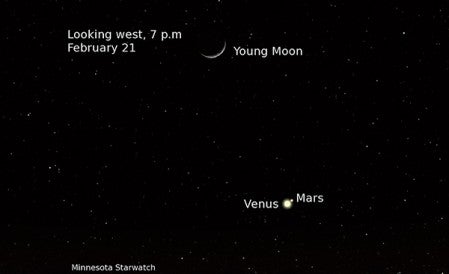Minnesota Sports Watch: Short, exciting month
Published 5:56 pm Saturday, January 31, 2015
 By Deane Morrison
By Deane Morrison
For a short month, February packs a lot of action, starting with the planets.
While Jupiter climbs in the east, Venus vaults up from the western horizon and waxes brilliant against the fading sunset. By mid-month, nightfall leaves the sky bookended by these two brightest of planets.
On the 21st Venus makes a close pass by Mars below a young crescent moon. Look an hour after sundown to find Mars, by far the dimmer body, just to Venus’s upper right. As Venus keeps climbing, the two planets separate.
Jupiter reaches opposition on the 6th, when Earth laps it in the orbital race and the planet appears opposite the sun in the sky. This year will be its closest opposition until 2019. Jupiter will be 404 million miles from Earth, which is 4.3 times the Earth-sun distance. The bright star following on the heels of Jupiter is Regulus, the heart of Leo, the lion.
Jupiter comes to opposition every 13 months because it takes about 12 years to orbit the sun. Here’s why: If we start the clock running with Jupiter at opposition, during the first year Jupiter moves one-twelfth of the way around the sun while Earth orbits once and ends up at the starting point. So then we have to go an extra one-twelfth of our orbit in order to line up with Jupiter again, and that takes one month. Therefore, it adds up to about one year plus one month between laps of Jupiter. Accordingly, next year’s Jupiter opposition falls on March 8.
On the third a full moon rises right after sunset, only a few minutes after the moment of perfect fullness. This means a gorgeously round moon against a pale sky. This moon has been called the full hunger moon and the full snow moon. These names are related in that the deep snows of February made hunting difficult, and so this was a particularly harsh month for northern Indian tribes.
Groundhog Day began as an ancient Celtic holiday called Imbolc, or lamb’s milk; it was one of four “cross-quarter” days falling midway between a solstice and an equinox. It was thought that sun and shadows on that day foretold more cold, while clouds and no shadows meant rains to soften the earth for planting. Hence our ritual in which the groundhog seeing its shadow means six more weeks of winter, but no shadow means spring is right around the corner.
The University of Minnesota offers public viewings of the night sky at its Duluth and Twin Cities campuses. For more information and viewing schedules, see:
Duluth, Marshall W. Alworth Planetarium: www.d.umn.edu/planet. Twin Cities, Minnesota Institute for Astrophysics (during fall and spring semesters): www.astro.umn.edu/outreach/pubnight. Check out the astronomy programs at the University of Minnesota’s Bell Museum ExploraDome: www.bellmuseum.umn.edu/ForGroups/ExploraDome/index.htm.
Contact: Deane Morrison, University Relations, (612) 624-2346,morri029@umn.edu. Find U of M astronomers and links to the world of astronomy athttp://www.astro.umn.edu.




